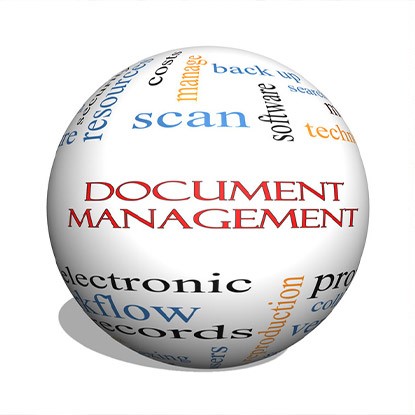Manufacturing Document Management:
Strategies, Techniques, and Tips


Whether you're a large-scale manufacturer or a small production facility, implementing effective document management practices is essential for maintaining competitiveness, meeting regulatory requirements, and ensuring the highest standards of product quality.
Within the dynamic ecosystem of a manufacturing factory floor, paper trails can quickly become tangled, hindering productivity, hampering compliance, and jeopardizing production schedules. Not to worry! We give you a guide to building a harmonious document management strategy within your manufacturing system.
We cover the benefits of employing dedicated document management systems (DMS), exploring how they can streamline workflows, enhance data accuracy, and ensure regulatory compliance. We’ll also illuminate best practices for document organization, version control, and access management, empowering you to transform your paper maze into a well-organized data hub.
Whether you’re a seasoned production manager confronting document chaos or a newly appointed quality control specialist seeking proactive solutions, this article equips you with the knowledge and actionable strategies to elevate your document management practices.
Revolutionize Your Manufacturing Workflow with InvoiceAction!
Ready to supercharge your invoice processing? InvoiceAction by Artsyl is your solution for seamless, automated invoice management in manufacturing. Quit manual data entry and enter efficiency!
Book a demo now
Manufacturing document management is a critical aspect of maintaining efficiency and compliance in the industry. However, it comes with its share of challenges. Here are some common hurdles faced in manufacturing document management.
Keeping track of document versions, especially in dynamic manufacturing environments, can be challenging. Changes made by multiple users or departments may lead to confusion, potentially resulting in errors or delays in production.
Ensuring that the right personnel have timely access to the latest documents is often a struggle. In manufacturing, where rapid decision-making is crucial, delays caused by restricted document access can hinder operational efficiency.
Compliance with industry regulations and standards is paramount in manufacturing. Documenting processes and ensuring that documents meet regulatory requirements adds complexity to document management, and failure to comply can lead to serious consequences.
Many manufacturing facilities still rely on paper-based documentation, making it difficult to manage and share information efficiently. This manual approach often leads to increased administrative overhead, slower processes, and a higher risk of errors.
Protecting sensitive manufacturing data is a constant concern. With the rise of digital documentation, ensuring data security against unauthorized access or cyber threats becomes a significant challenge that manufacturers must address.

RELATED: Manufacturing Accounting: Everything You Need to Know
Manufacturing processes involve multiple systems, such as Enterprise Resource Planning (ERP) and Product Lifecycle Management (PLM). Integrating these systems with document management platforms can be complex, requiring seamless data flow across different platforms.
As manufacturing companies grow, the volume of documents also increases. Traditional document management systems may struggle to scale efficiently, leading to performance issues and difficulty in managing the expanding document repository.
Locating specific documents quickly is crucial in manufacturing. Inefficient search and retrieval mechanisms can waste valuable time, impacting production schedules and hindering decision-making processes.
Addressing these challenges requires a strategic approach, often involving the adoption of modern document management technologies, employee training, and a commitment to continuous improvement in processes. Overcoming these hurdles not only enhances operational efficiency but also contributes to regulatory compliance and overall business success in the manufacturing sector.
Optimize Orders with OrderAction: Your Manufacturing Ally!
Tired of order processing bottlenecks? OrderAction is here to transform how you handle orders in manufacturing. Streamline workflows, enhance accuracy,
and boost productivity.
Book a demo now
Document Management Systems (DMS) play a crucial role in resolving common challenges associated with document management in manufacturing. Here’s how DMS can address these challenges.
Document Management Systems provide robust version control mechanisms. They track changes made to documents, allow users to access and edit the latest version, and maintain a clear audit trail. This ensures that everyone is working with the most up-to-date and accurate information.
Document Management Systems offer centralized repositories accessible from anywhere with an internet connection. This enhances document accessibility, allowing authorized personnel to retrieve, review, and collaborate on documents in real-time, regardless of their location.
Document Management Systems streamline compliance efforts by organizing documents in a structured manner. They facilitate quick retrieval of required documents during audits, help enforce document retention policies, and ensure that the latest compliance standards are consistently followed.
Transitioning from paper-based processes to digital is a strength of Document Management Systems. By digitizing documents, DMS eliminates the inefficiencies of manual paperwork, speeds up document retrieval, reduces the risk of document loss, and minimizes the environmental impact of paper usage.

Document Management Systems prioritize data security with features like access controls, encryption, and secure authentication. These measures protect sensitive manufacturing data from unauthorized access, ensuring that confidential information remains confidential.
Leading Document Management Systems offer integration capabilities with other manufacturing software like ERP and PLM systems. This integration ensures a seamless flow of information between different platforms, reducing data silos and enhancing overall efficiency.
Document Management Systems come equipped with advanced search functionalities. Users can quickly locate specific documents using metadata, full-text search, and indexing, reducing the time spent on searching and enhancing overall productivity.
By addressing these challenges, Document Management Systems empower manufacturing companies to streamline their document-related processes, enhance collaboration, and ensure compliance with industry standards and regulations. The result is a more efficient, secure, and scalable document management environment that positively impacts overall operational performance.

Take control of your financial processes in manufacturing with ArtsylPay. From invoice approvals to payment processing, ArtsylPay ensures accuracy and compliance. Ready to simplify your financial workflows?
A robust document management system is the backbone of an efficient and compliant manufacturing operation. It tackles document chaos, streamlines workflows, and boosts productivity, but what are the essential building blocks that make it all tick?
Say goodbye to scattered files and overflowing filing cabinets. An MDMS provides a single source of truth for all production-related documents, from blueprints and quality control reports to work instructions and safety protocols.
No more outdated manuals or confusing revisions. An MDMS tracks and manages different versions of documents, ensuring everyone accesses the latest and approved information. Controlled access ensures relevant individuals have the appropriate permissions to view, edit, or share documents.
Repetitive tasks like routing documents for approval or triggering notifications can be automated, freeing up valuable time for your team to focus on higher-value activities.
Finding the right document shouldn’t take a scavenger hunt. A robust search function enables quick and easy retrieval of specific documents based on keywords, dates, or other relevant criteria.
Data security is paramount. An MDMS should offer robust security features like access control, encryption, and audit trails to ensure compliance with industry regulations and protect sensitive information.
Seamless integration with your existing ERP, PLM, or other manufacturing software systems eliminates data silos and facilitates smooth information flow across departments.
As your needs evolve, your MDMS should be able to adapt. Choose a system that is scalable to accommodate future growth and easy to use for all team members, regardless of their technical expertise.
Extract valuable insights from your document data. An MDMS with reporting and analytics capabilities can help you identify bottlenecks, track trends, and make data-driven decisions to continuously improve your document management processes.
As an additional block, consider moving beyond paper-based documents by incorporating digital signatures, document scanning, and electronic forms to further streamline your operations and reduce environmental impact.
By carefully selecting and implementing these building blocks, you can create a powerful MDMS that transforms your document management from a chaotic burden to a well-oiled engine driving efficiency, compliance, and success in your manufacturing endeavors.
Empower Your Manufacturing Journey with docAlpha!
Ready to elevate your document management game? docAlpha is your key to digitizing, organizing, and securing manufacturing documents. From invoices to quality control records, docAlpha has you covered. Click to embark on a digital transformation!
Book a demo now
A large manufacturing company faced challenges in maintaining version control of critical product specifications, quality control documents, and production procedures. The existing paper-based system resulted in delays, errors, and difficulties in ensuring regulatory compliance.
The company implemented a robust Document Management System that digitized its document repository. The DMS provided version control features, allowing engineers and quality control teams to collaboratively edit and update documents. Integration with the existing ERP system ensured seamless data flow.
Teams could collaborate in real-time, reducing delays in product development and quality control processes. The DMS facilitated adherence to industry standards, ensuring that all documents met regulatory requirements. Version control features minimized the risk of errors caused by outdated documents, enhancing overall product quality.
RELATED: Intelligent Document Processing for Manufacturing Firms
By adhering to these best practices, manufacturing organizations can enhance document management processes, streamline workflows, and achieve greater operational efficiency. Based on the industry research, here are key recommendations for effective document management in the manufacturing sector.
Research consistently highlights the importance of adopting a comprehensive Document Management System. A DMS streamlines document workflows, ensures version control, and provides a secure and centralized repository for all manufacturing-related documents.
Define standardized naming conventions for documents to enhance searchability and organization. Consistent naming practices improve the efficiency of document retrieval and reduce the likelihood of errors.
Utilize version control features to track changes in documents over time. This includes maintaining a detailed revision history that records who made changes, when they were made, and what specific alterations occurred. This practice helps ensure that users always access the latest and most accurate information.
Integrate the Document Management System with other manufacturing systems, such as Enterprise Resource Planning (ERP) or Product Lifecycle Management (PLM) systems. This integration ensures a seamless flow of information across different platforms, reducing data silos and enhancing overall efficiency.
RELATED: Manufacturing ERP Software Guide

Implement robust data security measures, including access controls, encryption, and regular security audits. Safeguarding sensitive manufacturing data is crucial for compliance with industry regulations and protecting against unauthorized access.
Transition from manual, paper-based document processes to digital formats. Research consistently indicates that digitization reduces administrative overhead, accelerates document retrieval, and minimizes the risk of document loss or damage.
Provide tools and features that enable mobile access to documents and support remote collaboration. This is especially relevant in today’s dynamic work environments, allowing teams to work efficiently regardless of their physical location.
Automate routine document workflows and approval processes to reduce manual interventions. Automation improves efficiency, minimizes errors, and accelerates the pace at which documents move through various stages of approval.
Continuous user training is crucial for successful document management. Regularly educate employees on the features and best practices of the Document Management System. This helps ensure that users are proficient in utilizing the system’s capabilities.
Regularly audit the document management processes and assess the effectiveness of the system. This includes evaluating user feedback, identifying areas for improvement, and staying updated with technological advancements in document management.
Unleash Efficiency: Combine InvoiceAction, OrderAction, and docAlpha!
Why settle for one when you can have a trio of efficiency? Combine the power of InvoiceAction, OrderAction, and docAlpha for a comprehensive manufacturing document management solution. Get in touch to unleash the full potential of your workflow.
Book a demo now
A Document Management System (DMS) is a software solution designed to organize, store, retrieve, and manage documents and information related to manufacturing processes. It provides version control, access controls, and collaboration features to streamline document workflows.
Version control is a system that manages changes to documents over time. In manufacturing document management, it ensures that users are working with the most current version of a document. Version control tracks revisions, edits, and updates, providing an audit trail of changes.
Document accessibility refers to the ease with which authorized personnel can retrieve and interact with documents. In manufacturing, it involves ensuring that relevant documents are readily available to the right individuals when needed, promoting efficient decision-making and collaboration.
Regulatory compliance in manufacturing document management involves adhering to industry regulations, standards, and legal requirements. This includes maintaining accurate records, following document retention policies, and ensuring that documents meet the specified compliance criteria.
Data security in manufacturing document management encompasses measures to protect sensitive information from unauthorized access, alteration, or disclosure. It involves implementing access controls, encryption, and secure authentication methods to safeguard manufacturing data.
Integration of systems in manufacturing document management involves connecting the Document Management System (DMS) with other software applications, such as Enterprise Resource Planning (ERP) or Product Lifecycle Management (PLM) systems. This ensures seamless data flow and collaboration across different platforms.
Scalability refers to the capacity of a Document Management System to handle an increasing volume of documents and users as a manufacturing business grows. A scalable system can accommodate the expanding document repository and user base without compromising performance.
Transform Your Manufacturing Operations: Try Artsyl’s Document Suite!
Ready for a document management revolution? Experience the synergy of Artsyl docAlpha. Simplify processes, enhance collaboration, and stay ahead in manufacturing. Click to transform your operations with docAlpha complete suite of solutions.
Book a demo now
You’ve now equipped yourself with the tools and insights to conduct a masterful performance in the intricate ballet of document management within your manufacturing system. Remember, continuous refinement is key to maintaining information precision and operational efficiency. Regularly evaluate your document processes, embrace emerging technologies, and foster a culture of data integrity within your team.
By diligently applying the strategies presented in this blog, you’ll not only unlock the potential of streamlined document management but also secure the benefits of enhanced compliance, improved production visibility, and a competitive edge in your industry. So, shed the shackles of paper chaos, embrace the power of data control, and watch your manufacturing processes flourish under the baton of well-orchestrated document management.
Document management in manufacturing refers to the systematic organization, storage, retrieval, and control of documents and information related to various processes within the manufacturing industry. It includes managing everything from product specifications and quality control documents to compliance records and operational manuals.
Effective document management is vital in manufacturing to ensure streamlined processes, compliance with industry regulations, and access to accurate information. It helps enhance collaboration, reduce errors, and improve overall operational efficiency.
Document management facilitates regulatory compliance by ensuring that all necessary documents, certifications, and records are organized and easily accessible. This helps manufacturers adhere to industry standards and regulatory requirements, avoiding legal issues and ensuring product quality.
Common challenges include version control issues, accessibility problems, maintaining regulatory compliance, transitioning from paper-based to digital processes, and ensuring data security. Overcoming these challenges requires a comprehensive document management strategy.
Document management systems (DMS) improve manufacturing processes by providing a centralized platform for document storage, version control, and collaboration. They enhance efficiency, reduce errors, and contribute to better decision-making throughout the production lifecycle.
Transitioning involves scanning and digitizing existing paper documents, implementing a DMS, and training employees on the new digital processes. Manufacturers often take a phased approach to ensure a smooth transition without disrupting daily operations.

Document management fosters collaboration by enabling real-time access to documents, version tracking, and secure sharing among team members. This facilitates better communication, accelerates decision-making, and ensures everyone works with the most up-to-date information.
Critical security measures include user access controls, encryption of sensitive data, regular system audits, and secure backup procedures. Manufacturers must prioritize data security to protect sensitive information from unauthorized access or cyber threats.
Yes, document management systems can integrate with other manufacturing software, such as Enterprise Resource Planning (ERP) and Product Lifecycle Management (PLM) systems. This integration ensures a seamless flow of data and documents across various platforms, improving overall efficiency.
Document management supports quality control by ensuring that the latest quality standards, specifications, and inspection procedures are easily accessible. This promotes consistency in manufacturing processes, reduces errors, and enhances the overall quality of the end products.